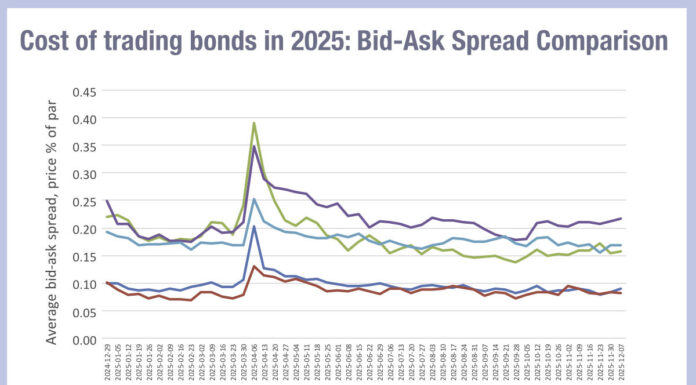A new set of emerging market credit futures is expanding the range of trading and investment support for specialist and multi-asset EM investors.
Nick Godec of S&P Dow Jones Indices and David Litchfield of Cboe Global Markets discuss the new Cboe iBoxx $ Emerging Market Bond Index Futures (IEMD) in June. The futures’ underlying is the iBoxx USD Liquid Emerging Markets Sovereigns & Sub-Sovereigns Index, which includes US dollar-denominated bonds issued by sovereign and sub-sovereign entities in emerging markets (EM), focusing on bonds that meet specific liquidity criteria. The futures are intended to offer investors a way to gain exposure to this index through a standardised, exchange-listed, tradable product, providing a tool for hedging, directional trading, or gaining market exposure to EM debt.
How is indexation impacting EM investing?

David Litchfield (DL): The impact of indexation on markets – including EMs – can create more trading activity in the underlying assets and make it easier for liquidity providers to access those markets through index products.
Competition from multiple indices also increases the range of assets that are covered – therefore potentially making a wider range of underlying securities tradable for market participants and in turn, enhancing the overall diversity and availability of market liquidity.
Can you outline the client demand you are seeing for Cboe IEMD futures?
DL: When we launched the very first credit futures for USD high yield (Ticker: IBHY) and USD investment grade (Ticker: IBIG), on the back of client demand, there was appetite for access to other exposures, notably EM debt. Away from the mainstream debt exposure, that’s the next biggest exposure most managers have.
What is the methodology behind the product?

Nick Godec (NG): The index is cut from the iBoxx USD Emerging Markets Broad Sovereigns & Sub-Sovereigns Benchmark, an unconstrained benchmark that includes all EM sovereign and sub-sovereign bonds with a par amount of at least US$250 million, so it’s broad in its inclusions, making it suitable performance measure for EM managers. To get to the Liquid Index underlying the IEMD futures, we significantly raise the debt outstanding minimums to US$1 billion, which reduces the number of bonds included from around 950 to 550 bonds and the par amount tracked from US$1.3 trillion to about US$960 billion from the parent to the sub index. What we find is the returns of the Liquid Index are near identical to the parent, however the higher notional thresholds improves the liquidity profile of the bonds by including bonds with greater trading activity and dealer depth. This was the best approach to designing an index meant to underlie tradable products, in that it balances the need for broad exposure while also focusing on more liquid positions with the application of that liquidity rule. We set a cap on the maximum weight that any given country can have in the index, to prevent over-concentration in any single nation.
Interestingly, the Broad Index that is the starting point for the index underlying the IEMD futures is an input to the construction process for the CDX Emerging Markets Index. CDX EM uses iBoxx country classifications and the set of countries in the index as one way to determine country eligibility, an interesting linkage within the EM ecosystem linkage from the start.
One key aspect of the methodology is the price source. Pricing is provided by the S&P Global Market Intelligence Bond Pricing Team. They review a number of points of colour, such as executed trades and dealer runs to list a few, to arrive at bond valuations that are unbiased, accurate, and therefore appropriate to feed into an index underlying tradable products like futures.
On final point on the iBoxx USD Liquid Emerging Markets Sovereigns & Sub-Sovereigns Index methodology – the rules are public so that anyone can understand how we put the index together. We also make index levels, key risk statistics & components freely available to support activity.
DL: Those investors that can and do trade CDX EM are able to do so. It’s not as liquid as the main exposures of IG and HY and there are swathes of the world that don’t have ISDAs and they’re not able to trade CDX EM. That was the genesis.
NG: If you look at CDX EMs, for instance, in 2023 that traded more than US$400 billion in gross notional. It is a deep market and is great for targeting credit risk. What hasn’t really existed, before the EM futures, was a way to trade the pure EM bond beta in a similar way to trading CDX EM. We worked really hard to make sure that the benchmark aligned with how investors understood the market, as we wanted this to be relevant to EM practitioners. The futures product is supported by multiple liquidity providers, so end users seeing better pricing, better levels of liquidity, and the ability to enter and exit in a more competitive market.
How is liquidity provision looking?
DL: Rather than being beholden to a few dealers, there is all-to-all trading in the futures product. It does not solely have a panel of liquidity providers, instead one can interact in the order book and reach CTAs, insurance companies, pensions, asset managers, hedge funds. That all-to-all liquidity – and diversity of liquidity – is very exciting in this space.
What are the use cases and demand levels for both specialist and non-specialist EM investors?
DL: An EM credit specialist has skills to select individual bonds and that is where they can genuinely add alpha. However, if they want to make very nimble and tactical allocations then the futures are an ideal instrument, e.g. if EMs are rallying and you can’t lay your hands on individual bonds, you want the beta. Similarly, if the world’s starting to sell off, the bids for individual bonds might be hard to come by but risk can be managed using the futures as a beta vehicle. Then alpha can be done later when the bids return. Multi-asset funds in large managers might want to make a tactical allocation to their in-house specialist but, because it’s a tactical trade, that specialist bond manager has to deploy that money across the range of bonds only to unwind the allocation in a few months’ time. Also, because it’s an internal allocation, it’s unlikely they will be paid the fees on it. It can be an operational and economic pain for them. Again, that is where the beta play works out.
NG: There is also operational efficiency. If you’re a specialist, instead of suffering potential cash drag, you can now set a position with the futures to fully deploy capital in the market. You have your beta exposure to your benchmark and you’re not suffering cash drag. Then you can deploy cash as you see your alpha generating position. That is highly valuable for the specialist. Alternatively, managers can use the futures to isolate the alpha of specific EM bonds in a beta neutral manner.
Where do these fit in the instrument selection process?
DL: The new IEMD futures fit in the toolkit and complement the existing USD investment-grade and USD high-yield futures. They can be used interchangeably, or alongside, existing products, depending on the implementation. If you want more cash-like exposure, then EM futures can be your tool to participate in existing liquidity from the cash bonds through to the EM ETFs. Users and would-be users of CDX EM will find this product fits into that existing ecosystem.
©Markets Media Europe 2024
©Markets Media Europe 2025












